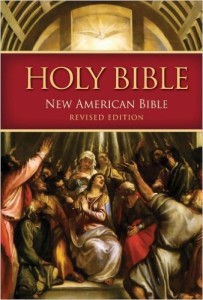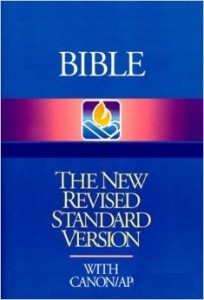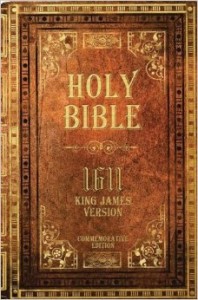
There’s only one bible, but there are many different versions of it. If you go to the bookstore or search online for a bible, you’ll find dozens of translations out there. Which one is right for me? Well, several of them are good, and none of them are terrible, so you really can’t go wrong with any bible you pick.
Still, some are better than others, and the most important feature of a bible is which translation it provides. You won’t always find that information on the outside cover. Publishers want you to focus on the color, the size, whether this edition is for teenagers or women, etc., etc., but open up the book to the first few pages to see who did the translating. After all, it’s the words of Scripture that you will be reading, not the fancy cover or the clever packaging.
Chances are that you’re looking at one of a few translations: the King James Version (or New King James Version), the New International Version, or the New Revised Standard Version (or the earlier Revised Standard Version). These aren’t bad translations (more about the King James Version in a minute), yet none of them are Catholic versions of the bible. That means they’re missing a few books from the Old Testament.
 The bible we read at mass is known as the New American Bible (or its 2011 revision, the New American Bible Revised Edition). If you were given a Catholic bible when you were younger or had to buy one for school, this is probably the translation you have. (It might also say “Saint Joseph edition” on it somewhere.) Another common Catholic version of the bible is the New Jerusalem Bible, which was produced by British scholars in 1985. Its English is very readable, and Americans will feel perfectly comfortable with this translation as well. A third option is the New Revised Standard Version Catholic Edition (or “with the Apocrypha, or “with the Deuterocanonical Books”). Even though this translation is not specifically Catholic, it has all the books you’ll need, and it’s a good translation too. In fact, if you’re in college this is probably the edition you’ll be required to buy for your theology classes.
The bible we read at mass is known as the New American Bible (or its 2011 revision, the New American Bible Revised Edition). If you were given a Catholic bible when you were younger or had to buy one for school, this is probably the translation you have. (It might also say “Saint Joseph edition” on it somewhere.) Another common Catholic version of the bible is the New Jerusalem Bible, which was produced by British scholars in 1985. Its English is very readable, and Americans will feel perfectly comfortable with this translation as well. A third option is the New Revised Standard Version Catholic Edition (or “with the Apocrypha, or “with the Deuterocanonical Books”). Even though this translation is not specifically Catholic, it has all the books you’ll need, and it’s a good translation too. In fact, if you’re in college this is probably the edition you’ll be required to buy for your theology classes.
Each of these different translations presents God’s Word in good English, yet each takes a slightly different approach. English is a very different language than Hebrew and Greek, which presents unique challenges for biblical scholars today. Again, all modern translations are fairly good, and all are based on the original Hebrew and Greek texts. However, some translations follow those texts more closely than others. Some stay very faithful to the original text and translate it almost word-for-word (like the New American Bible), while others offer a more fluid translation that sounds better in modern English (like the New Jerusalem Bible). All translations try to accomplish each of these goals together, but typically one of them has to be sacrificed for the other. The more literal the translation, the closer it will be to what the biblical authors wrote in Hebrew or Greek, yet the less pleasant the English will sound. The more pleasant the English sounds, the more the translation will deviate from the original text.
Readers will have their own preferences when it comes to which bible to choose. If you just want to read the bible and enjoy it, then you’ll want a translation that values the smoothness of the English over sticking to the original text. If you want to study the bible carefully and care about things like noticing when one passage alludes to another, then you’ll want a translation that emphasizes a close a word-for-word correspondence with the original. For tips on which translation best suits your needs, see the handy guide below.
Recommended
The New American Bible (NAB) [or as of 2011, the New American Bible Revised Edition]
The NAB is the official translation used in the Catholic mass and the version used by most Catholics today. Most of the translators for the NAB were Catholic priests and laypeople with extensive training in biblical languages, although a few Protestant scholars also participated. This translation sticks very close to the original text while at the same time offering a style of English that is fairly readable. The translation of the Old Testament was recently revised in 2011, while the New Testament translation was completed in 1986. You can find the New American Bible Revised Edition online here.
New Jerusalem Bible (NJB)
Just like the NAB, the NJB translation was performed by Catholic priests and lay scholars to provide a good edition for modern English-speaking Catholics. It also tries to follow the original Hebrew and Greek text closely but yields a smoother, more readable translation than the NAB. It also has a little bit more gender-inclusive language (e.g. “You shall not covet your neighbor’s spouse” instead of “you shall not covet your neighbor’s wife”), and it prefers to leave God’s name untranslated in the Old Testament: “Yahweh.” (Most other translations render the divine name as “Lord.”) You can find the New Jerusalem Bible online here.
New Revised Standard Bible (NRSV)
 The NRSV is not affiliated with the Catholic Church per se, nor with any Christian denomination. Instead, it is an ecumenical translation of the bible undertaken by scholars of various faiths. The NRSV was completed in 1989 by Protestant, Catholic, and Orthodox scholars working together (a Jewish scholar also helped with the Old Testament). Like the NAB, the NRSV aims to render the original text as closely as possible while also utilizing readable, modern English. A notable exception is its widespread use of gender-inclusive language (e.g., “brothers and sisters” instead of just “brothers”). Not all editions of the NRSV have the deuterocanonical books unique to Catholic bibles, so make sure to choose the NRSV Catholic Edition, which you can also find online here.
The NRSV is not affiliated with the Catholic Church per se, nor with any Christian denomination. Instead, it is an ecumenical translation of the bible undertaken by scholars of various faiths. The NRSV was completed in 1989 by Protestant, Catholic, and Orthodox scholars working together (a Jewish scholar also helped with the Old Testament). Like the NAB, the NRSV aims to render the original text as closely as possible while also utilizing readable, modern English. A notable exception is its widespread use of gender-inclusive language (e.g., “brothers and sisters” instead of just “brothers”). Not all editions of the NRSV have the deuterocanonical books unique to Catholic bibles, so make sure to choose the NRSV Catholic Edition, which you can also find online here.
Other Translations
Some people purchase or receive a bible that’s non-Catholic, or they have a Protestant bible before converting to Catholicism. They don’t have to get rid of it! There are several good Protestant translations out there, and differences between Catholics and Protestants have nothing to do with how they translate Scripture. The differences arise from how they interpret Scripture. Whenever you want to read from one of the “extra” books that Catholics have (i.e. the deutero-canonical books), you’ll need to use a different bible, but the following are good Protestant translations that are perfectly fine to use.
The New International Version (NIV) was the most popular version of the bible in the 20th century, and is used widely by Protestant Christians today. It is a generally reliable translation that stays pretty close to the original text while also being readable for a general audience. The same approach can be found in the New American Standard Version (NAS), which is even more faithful to the original text. The aforementioned New Revised Standard Version (NRSV) is also good, and if you’re just reading the Old Testament, the Jewish Publication Society translation (JPS) is a fine option too.
Discouraged
Douay-Rheims (American edition) (DRA)
Some translations aren’t so great, mostly because they’re too old or stray too far from the original text. Both are true of the Douay-Rheims bible. It was produced in 1899 and based on the Latin text of the Vulgate, meaning it was not based on the original Hebrew or Greek text. It is therefore a translation of a translation. In its day, this edition of the bible was very useful for English-speaking Catholics in the early 20th century, whose only other option was the King James Version. Thankfully the bishops commissioned the Catholic Biblical Assocation with translating Scripture from the original texts and into more modern English, resulting in the New American Bible in 1970. If you’d like to learn more about American Catholic history and want to see how people read the bible several generations ago, the Douay-Rheims bible makes of an interesting read. But if you want to know what the bible says, there are many translations today that are superior.
King James Version (KJV)
 Although a masterpiece in its own day, the King James Version is obsolete today for two reasons. First, the English language has evolved substantially since King James of England commissioned this translation in 1611. Some words in the KJV are either no longer in use or have changed meaning. For example, Moses tells God in Exodus 32:12 that He should “repent,” but the notion of God needing to repent is absurd! Moses is really asking for God to change His mind about something (which might still seem like a theological problem but is far more tolerable for modern readers). Reading the KJV feels a lot like reading Shakespeare. We can appreciate the artistry of both, but they speak English so differently than we do today that it’s easy to confuse the meaning.
Although a masterpiece in its own day, the King James Version is obsolete today for two reasons. First, the English language has evolved substantially since King James of England commissioned this translation in 1611. Some words in the KJV are either no longer in use or have changed meaning. For example, Moses tells God in Exodus 32:12 that He should “repent,” but the notion of God needing to repent is absurd! Moses is really asking for God to change His mind about something (which might still seem like a theological problem but is far more tolerable for modern readers). Reading the KJV feels a lot like reading Shakespeare. We can appreciate the artistry of both, but they speak English so differently than we do today that it’s easy to confuse the meaning.
The second reason the KJV is an inadequate translation today is because the 17th-century translators did not have access to as many manuscripts as we do today. So some passages in the KJV are no longer recognized as correct by modern scholars. Thankfully none of these passages are of great significance, but readers of the KJV might be surprised to learn that some passages (such as Mark 9:44) cannot be found in modern translations. (Check out your own bible, and you’ll probably find a footnote explaining the absence of some of these verses.) The process of how chapter numbers and verse numbers were added to the bible is a bit complex. Basically they were added several centuries ago, and during that time biblical scholars have determined that a few of these minor verses don’t actually belong in Scripture. (Check out the following examples: Matt 18:11; 23:14; Mark 9:44, 46; Mark 11:26; Mark 15:28; Luke 17:36; 23:17; John 5:3b-4; Acts 8:37; 15:34; 24:6b-8a; 28:29; Rom 16:24.)
New King James Version (NKJV)
Although the New King James Version uses modern English (as of 1982), it still relies on insufficient manuscript evidence for the New Testament and thus contains verses that are lacking in most other translations.
Today’s English Version (TEV) (a.k.a. the Good News Bible [GNB]) &
The New Living Translation (NLT)
The TEV (GNB) has a noble purpose, namely to make the English as up to date as possible. Instead of high, lofty sounding verses typical of bible translations, this version uses everyday language that the average person would speak. Unfortunately in doing so this translation deviates too far from the original meaning of the Hebrew and Greek, offering paraphrases that aren’t quite what the biblical authors had in mind. (To see the difference, compare the Book of Proverbs in this translation with any of the editions listed above.) The newer version of this translation, the Contemporary English Version (CEV), updates the 1976 version by using language current in 1995 but suffers from the same flaws. The New Living Translation (NLT) appeared a year later but also exhibits the same shortcomings.
*For a more thorough treatment of the numerous translations of Scripture available, visit here or here.
Humorous Translations
Some people have had a little fun with the bible by translating in ways meant to entertain readers. The versions below are not meant to be offensive or sacrilegious but light-hearted attempts to give bible enthusiasts something to enjoy.
* A cat’s translation of the bible
* A very modern retelling of the bible, with lots of slang (Amazon lets you view some pages of the book online)
* The New Testament translated into Hawaiian Pidgin, called Da Jesus Book (intended to bring the good news to indigenous people from the Hawaiian islands in their own language but funny sounding to native English speakers - scroll forward to read through the New Testament)
* The Gospel of Mark according to Hippies
The bible translated into Australian slang: The Aussie Bible (Or Bits of It Anyway!) by Kel Richards (available only in hard copy)
